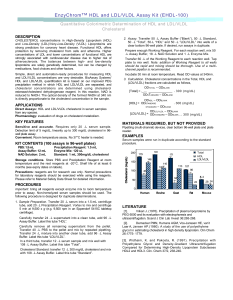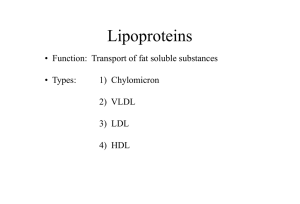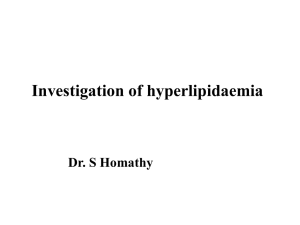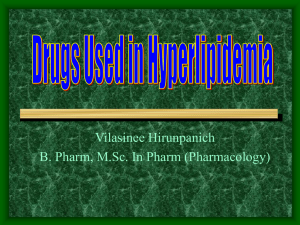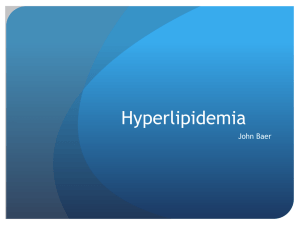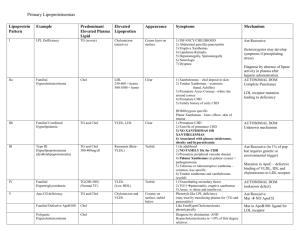EnzyChrom™ AF HDL and LDL/VLDL Assay Kit
advertisement
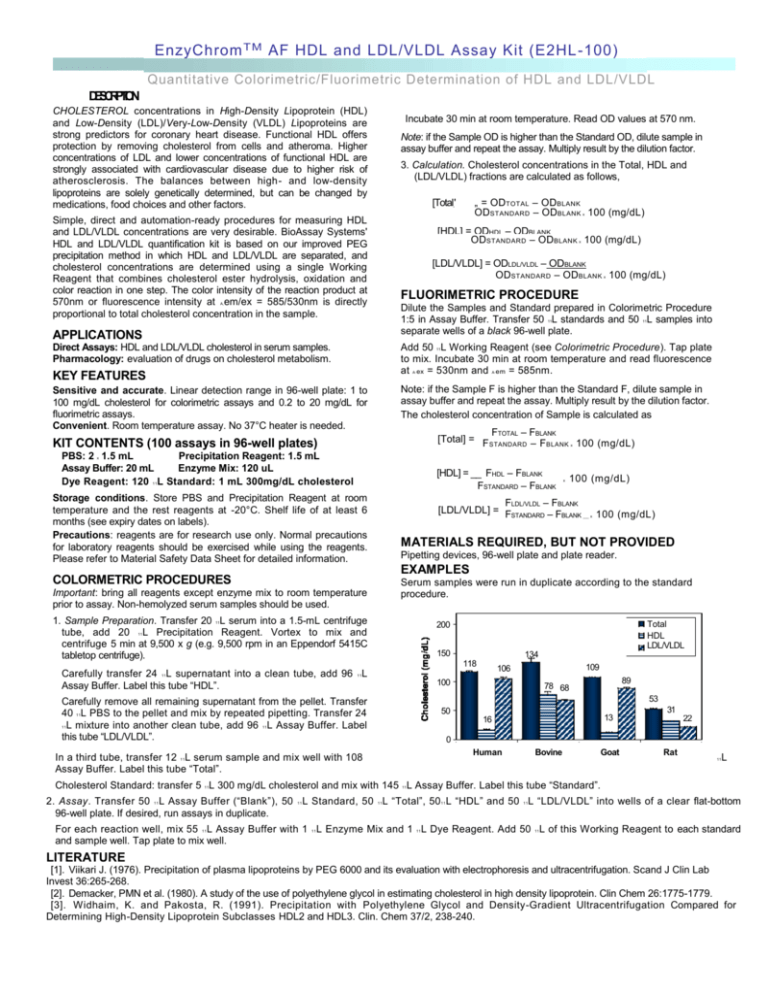
EnzyChrom T M AF HDL and LDL/VLDL Assay Kit (E2HL -100) Quantitative Colorimetric/Fluorimetric Determination of HDL and LDL/VLDL DESCRIPTION CHOLESTEROL concentrations in High-Density Lipoprotein (HDL) and Low-Density (LDL)/Very-Low-Density (VLDL) Lipoproteins are strong predictors for coronary heart disease. Functional HDL offers protection by removing cholesterol from cells and atheroma. Higher concentrations of LDL and lower concentrations of functional HDL are strongly associated with cardiovascular disease due to higher risk of atherosclerosis. The balances between high- and low-density lipoproteins are solely genetically determined, but can be changed by medications, food choices and other factors. Incubate 30 min at room temperature. Read OD values at 570 nm. Note: if the Sample OD is higher than the Standard OD, dilute sample in assay buffer and repeat the assay. Multiply result by the dilution factor. 3. Calculation. Cholesterol concentrations in the Total, HDL and (LDL/VLDL) fractions are calculated as follows, „ = ODTOTAL – ODBLANK ODSTANDARD – ODBLANK 100 (mg/dL) [Total.' x Simple, direct and automation-ready procedures for measuring HDL and LDL/VLDL concentrations are very desirable. BioAssay Systems' HDL and LDL/VLDL quantification kit is based on our improved PEG precipitation method in which HDL and LDL/VLDL are separated, and cholesterol concentrations are determined using a single Working Reagent that combines cholesterol ester hydrolysis, oxidation and color reaction in one step. The color intensity of the reaction product at 570nm or fluorescence intensity at em/ex = 585/530nm is directly proportional to total cholesterol concentration in the sample. [HDL] = ODHDL – ODBLANK ODSTANDARD – ODBLANK 100 (mg/dL) x [LDL/VLDL] = ODLDL/VLDL – ODBLANK ODSTANDARD – ODBLANK 100 (mg/dL) x FLUORIMETRIC PROCEDURE A, Dilute the Samples and Standard prepared in Colorimetric Procedure 1:5 in Assay Buffer. Transfer 50 L standards and 50 L samples into separate wells of a black 96-well plate. 11 APPLICATIONS Direct Assays: HDL and LDL/VLDL cholesterol in serum samples. Pharmacology: evaluation of drugs on cholesterol metabolism. 11 Add 50 L Working Reagent (see Colorimetric Procedure). Tap plate to mix. Incubate 30 min at room temperature and read fluorescence at ex = 530nm and em = 585nm. 11 KEY FEATURES A, A, Note: if the Sample F is higher than the Standard F, dilute sample in assay buffer and repeat the assay. Multiply result by the dilution factor. The cholesterol concentration of Sample is calculated as Sensitive and accurate. Linear detection range in 96-well plate: 1 to 100 mg/dL cholesterol for colorimetric assays and 0.2 to 20 mg/dL for fluorimetric assays. Convenient. Room temperature assay. No 37°C heater is needed. FTOTAL – FBLANK [Total] = F STANDARD – F BLANK 100 (mg/dL) KIT CONTENTS (100 assays in 96-well plates) x PBS: 2 1.5 mL Precipitation Reagent: 1.5 mL Assay Buffer: 20 mL Enzyme Mix: 120 uL Dye Reagent: 120 L Standard: 1 mL 300mg/dL cholesterol x [HDL] = __ FHDL – FBLANK FSTANDARD – FBLANK 11 Storage conditions. Store PBS and Precipitation Reagent at room temperature and the rest reagents at -20°C. Shelf life of at least 6 months (see expiry dates on labels). Precautions: reagents are for research use only. Normal precautions for laboratory reagents should be exercised while using the reagents. Please refer to Material Safety Data Sheet for detailed information. x 100 (mg/dL) FLDL/VLDL – FBLANK [LDL/VLDL] = FSTANDARD – FBLANK ___ x 100 (mg/dL) MATERIALS REQUIRED, BUT NOT PROVIDED Pipetting devices, 96-well plate and plate reader. EXAMPLES COLORMETRIC PROCEDURES Serum samples were run in duplicate according to the standard procedure. Important: bring all reagents except enzyme mix to room temperature prior to assay. Non-hemolyzed serum samples should be used. 1. Sample Preparation. Transfer 20 L serum into a 1.5-mL centrifuge tube, add 20 L Precipitation Reagent. Vortex to mix and centrifuge 5 min at 9,500 x g (e.g. 9,500 rpm in an Eppendorf 5415C tabletop centrifuge). 11 Total HDL LDL/VLDL 200 11 150 Carefully transfer 24 L supernatant into a clean tube, add 96 L Assay Buffer. Label this tube “HDL”. 11 134 118 109 106 11 100 53 Carefully remove all remaining supernatant from the pellet. Transfer 40 L PBS to the pellet and mix by repeated pipetting. Transfer 24 L mixture into another clean tube, add 96 L Assay Buffer. Label this tube “LDL/VLDL”. 50 11 11 89 78 68 13 16 31 22 11 0 Human In a third tube, transfer 12 L serum sample and mix well with 108 Assay Buffer. Label this tube “Total”. Bovine 11 Goat Rat 11 L Cholesterol Standard: transfer 5 L 300 mg/dL cholesterol and mix with 145 L Assay Buffer. Label this tube “Standard”. 11 11 2. Assay. Transfer 50 L Assay Buffer (“Blank”), 50 L Standard, 50 L “Total”, 50 L “HDL” and 50 L “LDL/VLDL” into wells of a clear flat-bottom 96-well plate. If desired, run assays in duplicate. 11 11 11 11 11 For each reaction well, mix 55 L Assay Buffer with 1 L Enzyme Mix and 1 L Dye Reagent. Add 50 L of this Working Reagent to each standard and sample well. Tap plate to mix well. 11 11 11 11 LITERATURE [1]. Viikari J. (1976). Precipitation of plasma lipoproteins by PEG 6000 and its evaluation with electrophoresis and ultracentrifugation. Scand J Clin Lab Invest 36:265-268. [2]. Demacker, PMN et al. (1980). A study of the use of polyethylene glycol in estimating cholesterol in high density lipoprotein. Clin Chem 26:1775-1779. [3]. Widhaim, K. and Pakosta, R. (1991). Precipitation with Polyethylene Glycol and Density-Gradient Ultracentrifugation Compared for Determining High-Density Lipoprotein Subclasses HDL2 and HDL3. Clin. Chem 37/2, 238-240.
